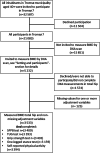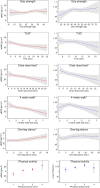Physical capability, physical activity, and their association with femoral bone mineral density in adults aged 40 years and older: The Tromsø study 2015-2016
- PMID: 33864108
- PMCID: PMC8510966
- DOI: 10.1007/s00198-021-05949-9
Physical capability, physical activity, and their association with femoral bone mineral density in adults aged 40 years and older: The Tromsø study 2015-2016
Abstract
Since muscles can influence bone growth and vice versa, we examined if level of physical activity and physical capability tests can predict areal bone mineral density (aBMD). Both high activity level and good test performance were associated with higher aBMD, especially in women.
Introduction: Muscle influences bone formation and vice versa. Tests of physical capability and level of physical activity reflect various muscle qualities. We assessed the associations between total hip aBMD and physical activity as well as a range of standardized physical capability tests in an adult general population.
Methods: A total of 3 533 women and men aged 40-84 years, participating in the population-based cross-sectional Tromsø study in Norway in 2015-2016, were included. Linear regression was used to assess associations between aBMD and physical activity and the physical capability tests grip strength, Timed Up and Go (TUG), Short Physical Performance Battery (SPPB), and standing balance. Non-linear associations were examined in cubic spline models. Standardized regression coefficients were calculated to compare effect sizes across physical capability measures.
Results: In fully adjusted models, higher physical activity was positively associated with total hip aBMD in both sexes compared to a sedentary lifestyle. All tests of physical capability were associated with aBMD in women, SPPB showing the strongest association although effect sizes were too small to indicate clinically significant differences (1 point increase corresponded to an aBMD increase of 0.009 g/cm2, CI = 0.005 to 0.012). In men, SPPB and its subtests were associated with aBMD with chair rises showing the strongest association (1 s increase in execution time corresponded to an aBMD decrease of 0.005 g/cm2, CI = 0.008 to 0.002).
Conclusion: Physical activity was associated with aBMD, and tests of physical capability can account for some of the aBMD variations in adults aged 40 years and older, especially in women.
Keywords: Bone mineral density; Osteoporosis; Physical activity; Physical capability; Physical function.
© 2021. The Author(s).
Conflict of interest statement
The authors declare no competing interests.
Figures


Similar articles
-
A 15-year follow-up study of hip bone mineral density and associations with leisure time physical activity. The Tromsø Study 2001-2016.PLoS One. 2022 Jan 26;17(1):e0262228. doi: 10.1371/journal.pone.0262228. eCollection 2022. PLoS One. 2022. PMID: 35081131 Free PMC article.
-
Leisure time physical activity in adulthood is positively associated with bone mineral density 22 years later. The Tromsø study.Eur J Epidemiol. 2010 May;25(5):325-31. doi: 10.1007/s10654-010-9450-8. Epub 2010 Mar 28. Eur J Epidemiol. 2010. PMID: 20349268
-
Associations of Muscle Size and Density With Proximal Femur Bone in a Community Dwelling Older Population.Front Endocrinol (Lausanne). 2020 Jul 28;11:503. doi: 10.3389/fendo.2020.00503. eCollection 2020. Front Endocrinol (Lausanne). 2020. PMID: 32849289 Free PMC article.
-
The influence of snuff and smoking on bone accretion in late adolescence. The Tromsø study, Fit Futures.Arch Osteoporos. 2021 Sep 27;16(1):143. doi: 10.1007/s11657-021-01003-7. Arch Osteoporos. 2021. PMID: 34570277 Free PMC article.
-
Exercise, Osteoporosis, and Bone Geometry.Sports (Basel). 2017 May 12;5(2):29. doi: 10.3390/sports5020029. Sports (Basel). 2017. PMID: 29910388 Free PMC article. Review.
Cited by
-
Bidirectional mediation of bone mineral density and brain atrophy on their associations with gait variability.Sci Rep. 2024 Apr 11;14(1):8483. doi: 10.1038/s41598-024-59220-2. Sci Rep. 2024. PMID: 38605086 Free PMC article.
-
The association between physical activity and the prevalence of comorbidity: a cross-sectional survey.Sci Rep. 2025 Jul 1;15(1):21040. doi: 10.1038/s41598-025-06064-z. Sci Rep. 2025. PMID: 40596175 Free PMC article.
-
Mediterranean Diet In Healthy Aging.J Nutr Health Aging. 2021;25(9):1076-1083. doi: 10.1007/s12603-021-1675-6. J Nutr Health Aging. 2021. PMID: 34725664 Free PMC article. Review.
-
Cross-sectional associations between accelerometer-measured physical activity and hip bone mineral density: the Tromsø Study 2015-2016.JBMR Plus. 2024 May 6;8(7):ziae061. doi: 10.1093/jbmrpl/ziae061. eCollection 2024 Jul. JBMR Plus. 2024. PMID: 38868594 Free PMC article.
-
The prevalence of osteoporosis in China, a community based cohort study of osteoporosis.Front Public Health. 2023 Feb 16;11:1084005. doi: 10.3389/fpubh.2023.1084005. eCollection 2023. Front Public Health. 2023. PMID: 36875399 Free PMC article.
References
-
- Blain H, Jaussent A, Thomas E, Micallef JP, Dupuy AM, Bernard PL, Mariano-Goulart D, Cristol JP, Sultan C, Rossi M, Picot MC. Appendicular skeletal muscle mass is the strongest independent factor associated with femoral neck bone mineral density in adult and older men. Exp Gerontol. 2010;45(9):679–684. doi: 10.1016/j.exger.2010.04.006. - DOI - PubMed
MeSH terms
LinkOut - more resources
Full Text Sources
Other Literature Sources
Medical

